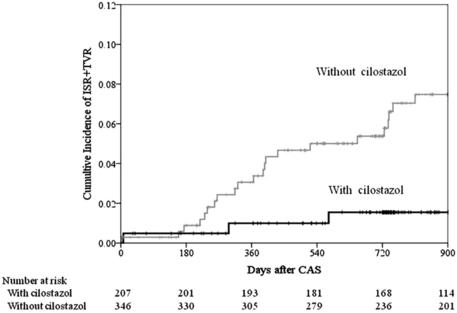Carotid and Cerebrovascular Disease
Periprocedural Cilostazol Treatment and Restenosis after Carotid Artery Stenting: The Retrospective Study of In-Stent Restenosis after Carotid Artery Stenting (ReSISteR-CAS)
Evidence Ranking
• C
Expert Rating
• 1
Abstract
Restenosis after carotid artery stenting (CAS) is a critical issue. Cilostazol can reduce restenosis after interventions in coronary or femoropopliteal arteries. We investigated whether periprocedural cilostazol treatment was related to the incidence of in-stent restenosis (ISR) or target vessel revascularization (TVR) after CAS. The study group comprised 553 of 580 patients who underwent CAS between April 2003 and August 2006 and were followed for 30 months after the procedure. ISR was defined as stenosis of at least 50% detected on angiography or ultrasonography. TVR was defined as revascularization of the treated carotid artery. During CAS, 207 patients (37.4%) were treated with cilostazol. Over 30 months, ISR occurred in 23 patients (4.2%), TVR occurred in 16 patients (2.9%), and either ISR or TVR occurred in 25 patients (4.5%). The incidence of ISR or TVR was significantly lower in the cilostazol-treated group than in the untreated group (1.4% vs 6.4%; log-rank P = .006). In a multivariate analysis, cilostazol treatment (hazard ratio [HR], 0.28; 95% confidence interval [CI], 0.08-0.95; P = .041) and stent diameter (HR, 0.73/1-mm increase; 95% CI, 0.54-0.99; P = .044) were independent factors for the occurrence of ISR or TVR. The incidence of a composite of events, including thromboembolism, hemorrhage, death, and TVR, tended to be lower in the cilostazol-treated group than in the untreated group (15.0% vs 19.9%; log-rank P = .17). Periprocedural cilostazol treatment was associated with lower rates of ISR and retreatment after CAS. A prospective randomized controlled trial is needed to clarify the effect of cilostazol on ISR after CAS (Fig 1).
Stay updated, free articles. Join our Telegram channel

Full access? Get Clinical Tree



